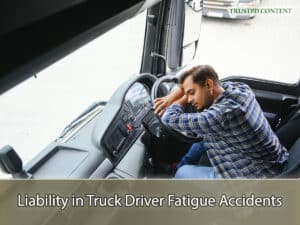Pursuing Justice for a Truck Driver Fatigue Accident in Ontario, California
Truck driver fatigue represents a significant risk on the roadways, particularly in California where the vast network of highways often serves as commercial lifelines. Accidents caused by fatigued truck drivers not only result in severe injuries but also raise complex legal questions about liability and compensation. This article discusses the implications of truck driver fatigue and the legal avenues available for victims seeking justice in such cases.
Understanding Truck Driver Fatigue
Fatigue in truck drivers can be caused by various factors including long hours, inadequate rest, and the pressure to meet tight delivery schedules. The condition not only impairs a driver’s reaction time but also affects their ability to make decisions and recognize potential hazards. Legally, truck drivers and their employers are required to adhere to strict regulations regarding hours of service to help mitigate these risks. These laws are designed to ensure drivers have sufficient rest between shifts, thereby reducing the likelihood of fatigue-related incidents.

Legal Accountability in Fatigue-Related Auto Accidents
Legal Accountability in Fatigue-Related Auto Accidents
The law places a duty of care on truck drivers to manage their fatigue and operate their vehicles safely. When a truck driver fails to comply with hours of service regulations and an accident occurs, both the driver and their employer can be held liable. This section of the law is critical as it underscores the responsibility of trucking companies to enforce these regulations and maintain detailed logs of their drivers’ hours.
Key Trucking Regulations and Their Impact
Here are the crucial components of the Hours of Service (HOS) regulations, which are designed to combat driver fatigue and enhance road safety:
- 11-Hour Driving Limit: Truck drivers may drive for up to 11 hours following 10 consecutive hours off duty.
- 14-Hour Limit: Drivers cannot operate beyond the 14th consecutive hour after coming on duty, following 10 consecutive hours off duty. This includes all on-duty activities, not just driving.
- 30-Minute Break Requirement: Drivers must take a minimum 30-minute break after 8 cumulative hours of driving without interruption. This break can be satisfied by any non-driving period of 30 consecutive minutes.
- 60/70-Hour Limit: Drivers cannot drive after accumulating 60 hours on duty over 7 consecutive days, or 70 hours over 8 consecutive days. They may restart the 7/8 day period after taking 34 consecutive hours off duty.
- Sleeper Berth Provision: Drivers can split their required 10-hour off-duty period into two segments. One segment must be at least 2 hours long, and the other must involve at least 7 consecutive hours spent in the sleeper berth. When properly paired, neither period counts against the 14-hour driving window.
These regulations ensure that truck drivers have sufficient rest periods to safely operate their vehicles, thereby reducing the risk of fatigue-related accidents.

Liability in Truck Driver Fatigue Accidents
Liability in Truck Driver Fatigue Accidents
In cases of truck driver fatigue accidents, establishing liability involves proving that the driver or the trucking company failed to follow required safety protocols. Liability isn’t limited to just the drivers; it often extends to the trucking companies themselves, especially when it can be shown that they did not enforce compliance with federal and state regulations.
Scenarios Where Truck Drivers Are Held Liable
- Violations of hours of service regulations.
- Failing to take mandated rest breaks.
- Inaccurate or falsified log entries.
Trucking companies might also face legal consequences under the theory of “vicarious liability,” where employers are held responsible for the actions of their employees committed in the course of their employment.
Other Liable Parties in Truck Accidents
While truck drivers and their employers are the primary focus in fatigue-related accidents, other parties may also bear responsibility. For instance, government entities tasked with road maintenance might be liable if unsafe road conditions contributed to the accident. Additionally, manufacturers could be held accountable if faulty vehicle parts or systems failed and led to the incident.
Contributing Factors from Other Parties
- Governmental negligence in maintaining safe road infrastructure.
- Manufacturer defects that lead to critical vehicle malfunctions.
Understanding the full scope of potential liabilities is crucial for providing comprehensive legal advice and representation to victims of truck driver fatigue accidents. Each case may involve multiple responsible parties, making the legal landscape quite complex but also offering several avenues for seeking compensation.
Legal Recourse for Victims of Truck Accidents
Victims of truck driver fatigue accidents have various legal avenues to pursue compensation for their injuries and losses. Understanding the legal recourse available is paramount to building a robust case.
Steps to Pursue a Claim
- Gather evidence: Collecting evidence such as driver logbooks, witness statements, and accident scene photographs.
- Establish negligence: Demonstrating that the truck driver or company failed to adhere to safety regulations.
- Calculate damages: Estimating the full extent of physical, emotional, and financial damages incurred.
Legal Process and What to Expect
The legal process for handling truck driver fatigue accident claims can be daunting due to its procedural demands and the necessity for detailed evidence. Victims can expect several stages in their pursuit of justice, from initial consultations with an attorney to potentially appearing in court.
Initial Consultations and Case Evaluation
During the initial consultation, a lawyer will evaluate the case based on the evidence available and advise on the best legal strategies. This is a crucial step for setting realistic expectations and preparing for the legal journey ahead.
Filing Claims and Negotiations
Once a claim is formally filed, the negotiation phase with insurance companies or opposing legal representatives begins. Many cases are settled during this phase without the need for a trial.
Trial Proceedings
If a settlement is not reached, the case may proceed to trial. Here, both sides will present their evidence, and a judge or jury will make a ruling. The complexity of truck accident cases often requires expert testimonies and detailed accident reconstructions.

Pursuing Justice for a Truck Driver Fatigue Accident in Ontario, California
Pursuing Justice for a Truck Driver Fatigue Accident in Ontario, California
If you or someone you know has been involved in a truck driver fatigue accident in California, it is essential to secure expert legal help promptly. At Napolin Accident Injury Lawyer, we provide a free consultation to discuss your case and help you understand your legal options.
With extensive litigation experience in southern California, our firm is dedicated to advocating for the rights of accident victims and ensuring they receive the compensation they deserve. Don't hesitate to contact us at (909) 962-8415 to protect your rights and begin the journey toward recovery and justice. We understand the intricacies of truck accident cases and are prepared to fight tirelessly for your best interests, leveraging our knowledge and resources to achieve a favorable outcome.
